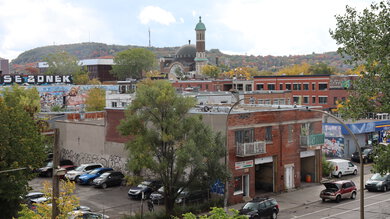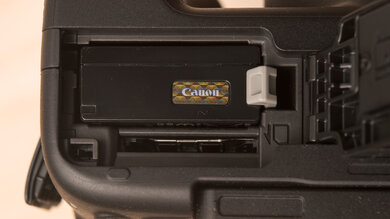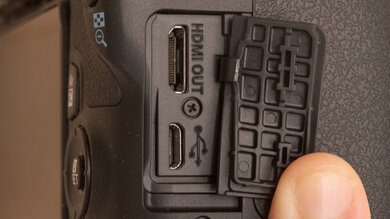The Canon EOS Rebel SL3/250D is an APS-C DSLR camera that's compact and easy to use. It takes decently sharp images, has a reasonably effective autofocus system, and is fitted with a responsive, fully-articulated touchscreen interface. It offers a wide range of ports and connectivity options for videographers and can shoot 4k and FHD video. Unfortunately, the image and video stabilization performance isn't especially impressive overall, so you may need to use a tripod for some shots, and the video quality is mediocre in 4k.
Our Verdict
The Canon SL3 is alright for travel photography. It offers satisfactory overall image quality, has an ergonomic design, and is equipped with an autofocus system well-suited to tracking moving objects. It also has a really good battery life for photos that can last multiple days on a full charge, depending on how you use it. However, its plastic build doesn't feel especially sturdy, and the camera is bulkier than mirrorless alternatives.
-
Ergonomic design.
-
Good battery life.
-
Relatively bulky.
-
Mediocre build quality.
The Canon Rebel SL3 is good for landscape photography. It keeps noise in images to a fairly low level, though it struggles a bit in very dim conditions. Its fully articulated screen is bright enough to be seen in direct sunlight. While it's relatively compact for a traditional DSLR, those accustomed to using point-and-shoots or phones to take pictures may find it a little bulky and tricky to carry around on a hike.
-
Ergonomic design.
-
Good battery life.
-
Relatively bulky.
-
Mediocre build quality.
The Canon SL3 is okay for sports and wildlife photography. Its autofocus system is reasonably effective and does a good job of tracking inanimate objects, like cars on a track. Its relatively slow, continuous shooting speed can make capturing specific shots of fast-moving subjects a little harder. Its silent shooting mode is also relatively loud, which may scare off nearby wildlife.
-
Ergonomic design.
-
Relatively bulky.
-
Relatively slow continuous shooting speed.
The Canon Rebel SL3 has decent RAW image quality. Its dynamic range is good, so it captures a fair range of highlight and shadow detail. Images also have good resolution and fine detail, even when punching in a reasonable amount. However, the sensor's noise handling is just okay, so it isn't the best option for low-light shooting. However, depending on your lens, you can still get great results.
-
Good dynamic range.
-
Good resolution.
-
Noise performance in low light is adequate.
The Canon SL3 is decent for vlogging. Its fully articulated screen makes it easy to monitor yourself on camera, but it isn't the best choice for recording in 4k due to its terrible face tracking, poor image stabilization, and mediocre video quality in this resolution, as the footage is lacking in detail and looks grainy. It performs somewhat better in FHD, with much-improved face-tracking autofocus capability and passable video quality.
-
Ergonomic design.
-
Bright, fully-articulated touchscreen.
-
Great face-tracking capability in FHD.
-
Poor video stabilization performance in 4k.
-
Bad autofocus performance in 4k.
-
Mediocre recording quality in 4k.
The Canon SL3 is okay for studio video. It has an easy-to-use interface and a wide selection of inputs and outputs for videography accessories, like a microphone, headphones, and an external recorder. It performs best in FHD, with superb autofocus performance and passable video quality in controlled lighting conditions. Unfortunately, video quality in 4k is mediocre, and autofocus performance in that resolution is poor.
-
Wide selection of ports for video accessories.
-
Easy-to-use menu system.
-
Bad autofocus performance in 4k.
-
Mediocre recording quality in 4k.
The Canon SL3 isn't designed for action video. While it's compact for a DSLR, it's too large to be mounted on a helmet rig. It also isn't the most rugged of cameras, with no water resistance and cheap-feeling plastic construction. Lastly, it doesn't support 120 fps or 240 fps recording for slow-motion video.
-
Ergonomic design.
-
Relatively bulky.
-
Poor video stabilization performance in 4k.
-
Limited selection of frame-rate recording options.
- 7.2 Travel Photography
- 7.5 Landscape Photography
- 6.7 Sport & Wildlife Photography
- 7.3 Raw Photo Performance
- 7.4 Vlogging
- 7.0 Studio Video
- 3.1 Action Video
Changelog
- Updated Jul 10, 2024: We updated this camera's name from 'Canon EOS Rebel SL3' to 'Canon EOS Rebel SL3/250D' and added a note in the Differences Between Variants section about international naming variants.
- Updated Jan 29, 2024: Added text to the 'Raw Photo Performance' verdict box.
- Updated Jan 29, 2024: Converted to Test Bench 0.12.1.
- Updated Apr 24, 2023: Converted to Test Bench 0.12.
- Updated Feb 27, 2023: Converted to Test Bench 0.11.
Check Price
Differences Between Sizes And Variants
The Canon Rebel SL3 comes in two color variants: 'Black' and 'White'. We purchased the 'Black' variant with the EF-S 18-55mm f/4-5.6 IS STM lens, and you can see its label here. That said, we expect the 'White' variant to perform the same. You can also buy the camera in either color scheme without a lens.
It's also worth noting that the SL3 is called the Canon EOS 250D in markets outside of North America.
If someone comes across a differently-equipped variant of the Canon SL3, let us know in the discussions so we can update our review.
Popular Cameras Comparisons
The Canon EOS R50 is a bit better overall than the Canon EOS Rebel SL3/250D. It's more compact, with a better autofocus system and faster burst shooting, not to mention more advanced video capabilities. That said, the SL3 offers similar image quality, a longer battery life, and a wider selection of compatible lenses.
The Canon EOS Rebel SL3/250D is a bit better than the Canon EOS Rebel T7/2000D. It's a newer camera with a better sensor and processor, resulting in better overall image quality. It's also a bit better built, has a fully articulated screen, has a longer battery life, and can record 4k video.
The Canon EOS Rebel T8i/850D and the Canon EOS Rebel SL3/250D are both great beginner DSLRs. The major difference is their design; the SL3 is more portable, while the T8i offers slightly better ergonomics and a better overall autofocus system. Otherwise, they're quite evenly matched and use similar sensors.
The Nikon D780 is better than the Canon EOS Rebel SL3/250D, but they're aimed at photographers of different experience levels. The Canon is an entry-level DSLR with an APS-C sensor. The Nikon is an enthusiast-grade DSLR with a full-frame sensor, meaning it performs better in low light and offers more advanced features like a weather-sealed body, more physical buttons and dials, and more customization options. It has a more advanced autofocus hybrid autofocus system that's more reliable at tracking moving subjects, and it can shoot 4k video without a crop and has more frame rate options. Its battery life is considerably longer, too. The Nikon is also much heavier and bulkier than the Canon.
Test Results
- Rubber eyecup around the viewfinder feels comfortable and well-padded
- Hand grip should accommodate a wide variety of hand sizes, without fingers getting pinched between the body and lens
- Hand grip has a textured surface that provides a secure hold
- Adjusting aperture and ISO requires multiple button presses, as these settings can't be changed using only the command dials
- SD card can't be changed while the camera is mounted on a tripod due to bottom-hinged compartment door
- Intuitive to navigate
- Guide mode is also a helpful feature for novice users who want to understand the camera's features
- Some features may not appear in the camera's menu system until after they've been activated previously, like the focus peaking configuration options that only become visible after the LiveView Mode has been enabled
Comments
Canon EOS Rebel SL3/250D: Main Discussion
Let us know why you want us to review the product here, or encourage others to vote for this product.
This product has been merged with Canon EOS Rebel SL3 DSLR Camera with 18-55mm and 55. Follow the discussion here.































































